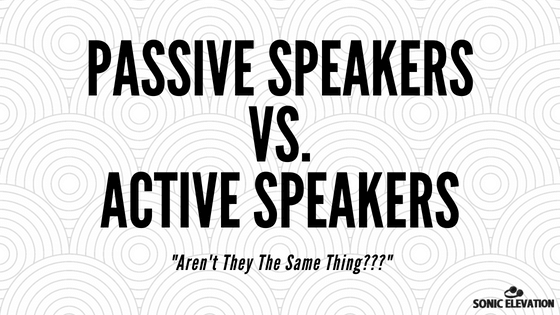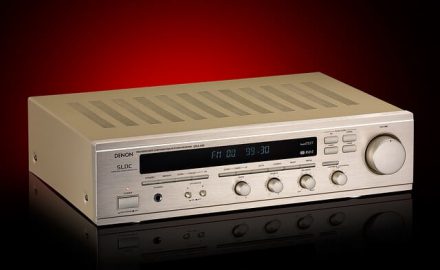
Passive Speakers vs Active Speakers
Speakers of all shapes, sizes, and types can be classified as fitting into one of two main categories. Passive or active. Becoming knowledgeable about passive speakers vs active speakers is an important step to take if you’re someone who’s in the market for a new pair of speakers.
Even if you’re not necessarily looking right now, it’s an extremely vital piece of information to have tucked away in the back of your mind for later.
We did our best to make it easy for you to follow along as we guide you through one of the most important distinguishing features in this area of audio equipment. By the end, you should have a pretty clear understanding of how to tell the difference, why it’s important, and a better sense of direction for the next time you’re ready to look around for a new set of speakers.

Passive Speakers vs Active Speakers
One of the easiest ways to tell these two types apart is to determine whether or not they have a built-in amplifier. In some cases, adding an external driving force (like an amp) is essential and will dramatically increase the level of sound fidelity.
On the other end of the spectrum – an external amp isn’t totally necessary since the speaker component already has one installed.
Before we get into the specifics of each type, it’s important to note that their respective crossover components are one of the main defining factors for differentiating between these two types of setups.
A Quick Note On Crossover Components
Crossover components lie at the core of how each specific speaker system operates. Their basic job and function is to essentially direct traffic. They control the direction and destination for where the signals from your output source are allowed to go.
An active crossover component has a dedicated channel of power for each individual tweeter, woofer, and sub. Active crossovers are generally more efficient which decreases their chance of heating up and distorting the sound of your audio after longer periods of use.
A passive crossover component, on the other hand, does not. They instead send the signals directly through the driver in each loudspeaker. This is one reason why the use of a preamp-to-amp setup is often recommended in order to have more control over your audio and the levels of your tweeter.
Take a look at the info-graphic below to see where these components are located in relation to the other components of your setup:

Now that you’ve learned about the difference between passive and active crossover components, let’s dive into the systems themselves.
Passive Systems
Passive systems do not have built-in amplification and are therefore usually a little bit trickier to set up for a first-time (or inexperienced) user. An external amp is absolutely necessary for them to properly function.
You’ll need a power source in order to drive the amp, and speaker wire to connect them to your receiver instead of a regular power outlet cable.

There are more moving pieces with a passive setup which is why it can start to get pretty complicated. When you’re setting up a home theater system, for example, additional equipment such as an external amp will be necessary.
Due to their lack of an internal amplifier, it can take some trial and error before you find the right equipment for your loudspeakers.
For example, finding a matching amplifier that’s compatible with the Klipsch R-15M will require some extra research. For some people, part of the fun is adding to your setup piece by piece and experimenting with different equipment. (If that doesn’t sound like fun you’ll definitely be better off with a pair of active speakers.)
Some systems include a separate amp to complete your setup, but that’s not always the case. In order to get the best audio quality, volume, and overall performance – adding an external amplifier is an essential investment. Although they’re not absolutely necessary for basic performance, it can make a world of difference.
Now that you have a general idea of how they operate, let’s go over a few pros and cons.
Pros:
- More flexibility when it comes to adding additional external components
- Do not require power cables – just regular speaker wire
- Ability to modify and personalize audio settings/presets
Cons:
- The tendency to lose heat which can cause a slight distortion in sound fidelity
- Harder to find compatible amps, etc. since manufacturers don’t make components that are one-size-fits-all
- Require amplifiers strong enough to power the entire system
Active Systems
Active systems have built-in amplifiers for each respective crossover component. In layman’s terms, this means that the subwoofer, woofer, and tweeter each have an amp directly assigned for powering their output.
Since the amps are built-in and already part of the entire package, these types of systems tend to take up less space. Systems of this type are closer to the “plug-n-play” setups that are usually ready to go right out of the box.

Powering The Internal Amplifier
Unlike passive setups, an active system’s internal amp needs a power source in order to function. This is one disadvantage as you won’t be able to simply run speaker wire into the unit. You will have to make sure you have one available power outlet per unit.
The Sonos One is a good example of an active speaker that only requires a power source and wireless connection to start playing your music.
Active systems don’t usually require extra attention to detail and additional background knowledge before you get your system up and running.
Adding additional external components like a preamp or phono preamp (for connecting a turntable), external amplifier, digital storage device, receiver, or laptop oftentimes require extra cables (that are specific to that device/speaker set).
Now that you have a general idea of how they operate, let’s go over a few pros and cons.
Pros:
- Consistent audio playback as designed by the manufacturers
- More compact
- Less additional equipment (amps, etc.) required
- Easier to connect multiple systems for playing music in larger areas (warehouse, outdoors, etc.)
Cons:
- Less freedom to experiment with additional external components (what you hear is what you get)
- Require extra power cables (one for each speaker)
Which One Works The Best?
If you’re wondering which one sounds better or which one you should get for your setup, the answer depends on what and where you plan on using them.
In terms of sound quality, users of both types are completely satisfied and claim that both meet (or surpass) their expectations. This is one of those discussions that has fans on both sides arguing why their system sounds better than the other.
Aside from the obvious differences in basic operation – the quality of audio playback will be debated until the end of time. A certain level of subjectivity will always exist when it comes to personal taste in which audio piece of gear sounds better, and why.

One Final Comparison
For a more-experienced audiophile or speaker-head, a passive system might be more exciting to piece together. The ability to have more overall control is also appealing to anyone that falls into that category.
If you’re getting ready to buy your first set of speakers, you’ll probably want to consider investing in an active set.
As you saw under the pros/cons section for active systems, this type would arguably perform better in large outdoor operations. Unless you have a shortage of power outlets, they’d also work great for a home theater or home studio setup.
What Matters The Most
What matters the most is that you know what you’re getting yourself into before making a big purchase. (That and being happy, or at least satisfied) with your final setup.
This is the bottom line. An active system is easier to understand, more compact, and requires less additional equipment. If you don’t want to deal with the hassle of extensive research or handling tons of extra cables and cords – we recommend trying an active system.
If you’re a quick learner (or don’t mind doing some research on your own) – passive might be the way to go. Our overall recommendations are based on your individual level of expertise, interest, and willingness to learn (if needed).
Taking on another project isn’t always everyone’s cup of tea. Exploring how your audio gear works and playing around with what works best is the response you’d get from others when asked “So, what did you do this weekend?”. (Then again, you might have a mix of both seeing as you did stumble upon our guide.)
If you take nothing else away from this, at least you know how passive speakers vs. active speakers differ from each other. You will also be able to articulate the main differences and how they play a significant role in your overall speaker experience.
Do you know more than you did before reading our guide? If someone asked you how to tell the difference would you be able to explain it to them in layman’s terms? Do these terms still seem so confusing that your brain wants to shut down and atrophy?
Hopefully, you answered “yes” to at least one of the first two questions. (If not, we’re not doing very well at our job.) If you’re still unsure, feel free to ask us for clarification by leaving your question in the comment section below.
Don’t forget, you can always bookmark this page to revisit (or save for later if you suffer from short term memory loss like so many of us do). Feel free to share this link with anyone else you know that’s curious and willing to learn!
If you want to stay here and surf around our site, take a look at our Best Bookshelf Speakers of 2018 countdown. Thanks for stopping by and sticking around til the end, we hope you enjoyed your time here!
Sonic Elevation: Ride The Waves.
- Korg B2 vs Roland FP10 | Which One To Buy - May 13, 2021
- How Does Music Affect The Brain? – Let’s Find Out! - April 6, 2021
- Why Are My Headphones Crackling? – How To Fix It - April 3, 2021